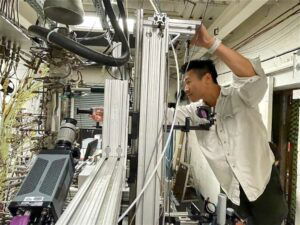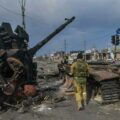A NASA-funded team of researchers has announced a breakthrough in hypersonic airflow technology, allowing operators to control airflow at the speed of light when a deadly “shock train” occurs.
A crash train is a condition that normally precedes the failure of a ramjet engine. For the first time, researchers at the University of Virginia School of Engineering and Applied Science have demonstrated the ability to monitor airflow through a supersonic combustion jet engine using an optical sensor instead of a pressure sensor.
This unprecedented level of detection and control gives engineers of the superscramjet engines used in hypersonic aircraft prototypes a completely new way to maintain engine performance above Mach 5, or five times the speed of sound, when a shock train is detected. Aircraft that operate above this threshold are called “hypersonic.”
“It made sense to us that if an aircraft is going to be flying at hypersonic speeds of Mach 5 and above, it might be better to integrate sensors that operate closer to the speed of light than the speed of sound,” said Professor Christopher Goyne, director of UVA’s Aerospace Research Laboratory, where the research took place.
Shock detection is essential for hypersonic flight
In the press release announcing the breakthrough in airflow sensing and control, the team points out that NASA’s experimental X-43, or “Hyper-X,” aircraft was capable of flying at hypersonic speeds 20 years ago. The final version of that aircraft, the X-43A, reached Mach 10 in 2004. That’s the fastest speed ever achieved by an air-breathing aircraft before or since.


Unfortunately, this program and the Air Force’s successor program, the X-51 Waverider program, used older technology to monitor and control the delicate airflow inside a hypersonic engine. Unlike a ramjet used by aircraft flying at supersonic speeds, a hypersonic ramjet must maintain airflow through it at supersonic speeds. Therefore, monitoring this airflow using a 2004 pressure sensor that operates at the speed of sound by monitoring pressure waves left engineers with very little time to react to adverse flow conditions.
“If you’re sensing at the speed of sound, but the engine processes are moving faster than the speed of sound, you don’t have much response time,” Goyne says.
The UVA team turned to optical sensors to give engineers much faster data so they could avoid the dreaded “no-start” condition, in which the airflow at the ramjet inlet falls below the supersonic threshold.
“If something happens in the hypersonic engine and subsonic conditions are suddenly created, the engine will not restart,” Goyne explained. “The thrust will suddenly decrease and it could be difficult at that point to restart the intake.”
Optical sensors find a whole new way to detect and prevent start-up
According to the team’s research published in the journal Aerospace Science and TechnologyThe team reasoned that monitoring intake airflow using optical sensors could give engineers the ability to modify engine conditions before an unplanned start occurs. However, unlike pressure sensors, these sensors would have to look for an optical signal that an unplanned start is about to occur, as opposed to the traditional telltale pressure wave that pressure sensors can detect.
To test their idea, the team used one of UVA’s many wind tunnels. Dubbed the UVA Supersonic Combustion Facility, this particular wind tunnel can simulate the engine conditions of a hypersonic vehicle traveling at Mach 5. Additionally, unlike testing aboard an actual aircraft traveling at hypersonic speeds, the wind tunnels can operate for extremely long periods of time. This flexibility allowed the researchers to collect an unprecedented amount of data on the performance of their optical sensors.


“We can run test conditions for hours, allowing us to experiment with new flow sensors and control approaches on realistic engine geometry,” explained Chloe Dedic, associate professor at UVA and co-author of the published research.
After several hours of testing, the team found what they were hoping for. By detecting the light emitted by the reactive gases in the ramjet combustion chamber, as well as the location and spectral content of the flame, the team was able to pinpoint the conditions leading to the failure to start. Called a “shock train,” this wave formation emitted a spectral signal spanning all three parameters that the team’s optical sensors were able to detect.
Indeed, by analyzing light spectra, they have found a way to monitor and control conditions inside the ramjet to detect and counter a shock chain before startup occurs. Moreover, since this occurs at the light seed level, their optical sensor approach to monitoring this category of airflow could help engineers anticipate one of the most vexing problems of air-powered hypersonic flight.
“The light emitted by the flame in the engine is due to the relaxation of molecular species excited during combustion processes,” explains Elkowitz, one of the doctoral students. “Different species emit light at different energies or colors, providing new information about the state of the engine that is not captured by pressure sensors.”
Research advances efforts to build single-stage spacecraft
Moving forward, UVA researchers will work on new test configurations with the goal of producing a working prototype optical crash train detector for real-world flight testing.


“We were very excited to demonstrate the role optical sensors could play in controlling future hypersonic vehicles,” said Max Y. Chern, a doctoral student and first author of the study. “We are continuing to test sensor configurations as we work toward a prototype that optimizes the package volume and weight for flight environments.”
Longer term, the researchers note that the ability to achieve hypersonic flight brings the world one step closer to the ultimate goal of a single-stage orbital craft that can take off like a traditional aircraft and also fly into space.
“Since the 1960s, one of our national aerospace priorities has been to build single-stage aircraft that can take off horizontally like a traditional airplane and land on the ground like a traditional airplane,” Goyne said. “Currently, the most advanced aircraft is the SpaceX Starship. It has two stages, with vertical launch and landing. But to maximize safety, convenience and reusability, the aerospace community would like to build something more like the 737.”
When asked whether such a goal can be achieved in his lifetime, Goyne was optimistic, especially given the enormous leap forward he said his team’s work represents.
“I think it’s possible, yes,” Goyne said. “While the commercial space industry has been able to reduce costs through reusability, it has not yet mastered aircraft-like operations. Our findings could potentially build on Hyper-X’s legendary history and make its access to space safer than current rocket-based technology.”
Christopher Plain is a science fiction and fantasy novelist and senior science editor at The Debrief. Follow and connect with him on X, Learn more about his books at plainfiction.com, or email him directly at christopher@thedebrief.org.